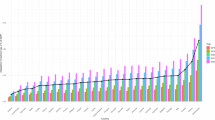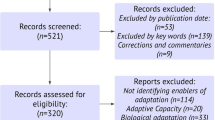Abstract
Amid escalating climate impacts, understanding private sector adaptation is critical. Here using data of actual adaptation expenditures from nearly 300,000 businesses in five coastal regions, we reveal variations in private sector adaptation across sectors and regions. The agriculture sector leads in adaptation efforts, while transport, construction and utilities—that is potential sources of system-wide cascading effects—lag. Small, medium and large businesses prioritize hard and soft measures, barely investing in ecosystem-based adaptations. Adding to the multifaceted discourse on adaptation effectiveness, our panel data reveal positive, although inelastic in the short run, relationships between private sector adaptations and aggregate regional economic performance. Business adaptations in the construction, transport and health sectors associate positively with regional economic performance, with the accommodation and food services sector yielding the highest return per euro invested in adaptation. Combining these findings with existing assessments of adaptation could support the development of societally effective adaptation strategies.
This is a preview of subscription content, access via your institution
Access options
Access Nature and 54 other Nature Portfolio journals
Get Nature+, our best-value online-access subscription
$32.99 / 30 days
cancel any time
Subscribe to this journal
Receive 12 print issues and online access
$259.00 per year
only $21.58 per issue
Buy this article
- Purchase on SpringerLink
- Instant access to full article PDF
Prices may be subject to local taxes which are calculated during checkout





Similar content being viewed by others
Data availability
The data on private sector adaptation investments that support the findings of this study are available from kMatrix Data Services. Restrictions apply to the availability of these data, which were used under license for the current study and are not publicly shareable. Any queries regarding the raw data should be directed to kMatrix Data Services (enquiries@kmatrix.org). Source data are provided with this paper.
Code availability
The Python code used to produce the display items and the STATA code used for the regression are available via Zenodo at https://doi.org/10.5281/zenodo.16602772 (ref. 51).
References
IPCC. Climate Change 2023: Synthesis Report (eds Core Writing Team et al.) 35–115 (IPCC, 2023).
Coronese, M. Going beyond averages. Nat. Clim. Change 14, 551–552 (2024).
Mandel, A., Battiston, S. & Monasterolo, I. Mapping global financial risks under climate change. Nat. Clim. Change 15, 329–334 (2025).
Bressan, G., Đuranović, A., Monasterolo, I. & Battiston, S. Asset-level assessment of climate physical risk matters for adaptation finance. Nat. Commun. 15, 5371 (2024).
Hennes, K., Bendig, D. & Löschel, A. Facing the storm: developing corporate adaptation and resilience action plans amid climate uncertainty. Npj Clim. Action 3, 37 (2024).
Resch, E. & Gao, J. Climate Change: Business Risks and Opportunities—The Role of Private Sector Adaptation (UNEP, 2022).
World Economic Forum. Accelerating Business Action on Climate Change Adaptation (2023).
Yohe, G., Knee, K. & Kirshen, P. On the economics of coastal adaptation solutions in an uncertain world. Clim. Change 106, 71–92 (2011).
Kondrup, C. et al. (eds) Climate Adaptation Modelling (Springer International, 2022).
Gawith, D., Hodge, I., Morgan, F. & Daigneault, A. Climate change costs more than we think because people adapt less than we assume. Ecol. Econ. 173, 106636 (2020).
Taberna, A., Filatova, T., Hadjimichael, A. & Noll, B. Uncertainty in boundedly rational household adaptation to environmental shocks. Proc. Natl Acad. Sci. USA 120, e2215675120 (2023).
Berrang-Ford, L. et al. A systematic global stocktake of evidence on human adaptation to climate change. Nat. Clim. Change 11, 989–1000 (2021).
Dubiel-Teleszynski, T. et al. System-Wide Amplification of Climate Risk (ECB, 2022).
Bank of England. Key Elements of the 2021 Biennial Exploratory Scenario: Financial Risks From Climate Change (2021).
Mendelsohn, R. Efficient adaptation to climate change. Clim. Change 45, 583–600 (2000).
Adger, N. W., Arnell, N. W. & Tompkins, E. L. Successful adaptation to climate change across scales. Glob. Environ. Change 15, 77–86 (2005).
McKnight, B. & Linnenluecke, M. K. How firm responses to natural disasters strengthen community resilience: a stakeholder-based perspective. Organ. Environ. 29, 290–307 (2016).
Crick, F., Eskander, S. M. S. U., Fankhauser, S. & Diop, M. How do African SMEs respond to climate risks? Evidence from Kenya and Senegal. World Dev. 108, 157–168 (2018).
Skouloudis, A. et al. Assessing Greek small and medium‐sized enterprises’ flood resilience capacity: index development and application. J. Flood Risk Manag. 16, e12858 (2023).
Josephson, A., Schrank, H. & Marshall, M. Assessing preparedness of small businesses for hurricane disasters: analysis of pre-disaster owner, business and location characteristics. Int. J. Disaster Risk Reduct. 23, 25–35 (2017).
Dookie, D. S., Conway, D. & Dessai, S. Organisational Preparedness for the Physical Risks of Climate Change in the UK (EGU General Assembly, 2023); https://doi.org/10.5194/egusphere-egu23-851
Neise, T., Sambodo, M. T. & Revilla Diez, J. Are micro-, small- and medium-sized enterprises willing to contribute to collective flood risk reduction? Scenario-based field experiments from Jakarta and Semarang, Indonesia. Organ. Environ. 34, 219–242 (2021).
Hashim, H. M., Ng, Y. G., Talib, O. & Md Tamrin, S. B. Factors influencing flood disaster preparedness initiatives among small and medium enterprises located at flood-prone area. Int. J. Disaster Risk Reduct. 60, 102302 (2021).
Leitold, R., Garschagen, M., Tran, V. & Revilla Diez, J. Flood risk reduction and climate change adaptation of manufacturing firms: global knowledge gaps and lessons from Ho Chi Minh City. Int. J. Disaster Risk Reduct. 61, 102351 (2021).
Henke, L., Knoth, K. & Sandberg, E. Climate change adaptation in Norwegian businesses—awareness, integration and barriers. Clim. Risk Manag. 45, 100647 (2024).
Gannon, K. E. et al. Adaptation to climate change in the UK wine sector. Clim. Risk Manag. 42, 100572 (2023).
Bag, S., Sabbir Rahman, M., Rogers, H., Srivastava, G. & Harm Christiaan Pretorius, J. Climate change adaptation and disaster risk reduction in the garment industry supply chain network. Transp. Res. E 171, 103031 (2023).
CDP. Climate Change, Forests, and Water Security Questionnairies: Guidance for Companies (2023).
Agrawala, S. et al. Private Sector Engagement in Adaptation to Climate Change: Approaches to Managing Climate Risks (OECD, 2011).
Goldstein, A., Turner, W. R., Gladstone, J. & Hole, D. G. The private sector’s climate change risk and adaptation blind spots. Nat. Clim. Change 9, 18–25 (2019).
Howard, S., Howard, S. & Howard, S. Quantitative market analysis of the European Climate Services sector—the application of the kMatrix big data market analytical tool to provide robust market intelligence. Clim. Serv. 17, 100108 (2020).
IPCC. Climate Change 2022—Impacts, Adaptation and Vulnerability (Cambridge Univ. Press, 2023).
Owen, G. What makes climate change adaptation effective? A systematic review of the literature. Glob. Environ. Change 62, 102071 (2020).
Singh, C. et al. Interrogating ‘effectiveness’ in climate change adaptation: 11 guiding principles for adaptation research and practice. Clim. Dev. 14, 650–664 (2022).
Danese, G. & De Marchi, V. Business adaptation strategies to climate change: a systematic review. J. Clean. Prod. 485, 144322 (2024).
Barrett, S. & Chaitanya, R. S. K. Getting private investment in adaptation to work: effective adaptation, value, and cash flows. Glob. Environ. Change 83, 102761 (2023).
Helgeson, J. & O’Fallon, C. Resilience dividends and resilience windfalls: narratives that tie disaster resilience co-benefits to long-term sustainability. Sustainability 13, 4554 (2021).
Bhutto, M., Khushik, A. G. & Bhutto, N. A. An analysis of private investment in economic growth in three major sectors of Pakistan. Prog. Res. J. Arts Humanit. 6, 113–123 (2024).
Fankhauser, S., Smith, J. B. & Tol, R. S. J. Weathering climate change: some simple rules to guide adaptation decisions. Ecol. Econ. 30, 67–78 (1999).
Fankhauser, S. & Tol, R. S. J. On climate change and economic growth. Resour. Energy Econ. 27, 1–17 (2005).
UNDRR. The Human Cost of Disasters: An Overview of the Last 20 Years (2000–2019) (2020).
Georgeson, L., Maslin, M., Poessinouw, M. & Howard, S. Adaptation responses to climate change differ between global megacities. Nat. Clim. Change 6, 584–588 (2016).
Herrmann, J. & Guenther, E. Exploring a scale of organizational barriers for enterprises’ climate change adaptation strategies. J. Clean. Prod. 160, 38–49 (2017).
Mendelsohn, R. The economics of adaptation to climate change in developing countries. Clim. Change Econ. 3, 250006 (2012).
Sakai, P. & Yao, Z. Financial losses and flood damages experienced by SMEs: who are the biggest losers across sectors and sizes? Int. J. Disaster Risk Reduct. 91, 103677 (2023).
European Commission. The Joint Harmonised EU Programme of Business and Consumer Surveys (2023).
Eurochambres. Access to Sustainable Finance for SMEs: A European Survey 2023 (2023).
World Bank. Enterprise Surveys Indicators Data—World Bank Group (2023).
Noll, B., Filatova, T., Need, A. & Taberna, A. Contextualizing cross-national patterns in household climate change adaptation. Nat. Clim. Change 12, 30–35 (2022).
Cortés Arbués, I., Chatzivasileiadis, T., Storm, S., Ivanova, O. & Filatova, T. Private investments in climate change adaptation are increasing in Europe, although sectoral differences remain. Commun. Earth Environ. 6, 470 (2025).
Filatova, T., Taberna, A., Chatzivasileiadis, T. & Cortes Arbues, I. Private sector investments in climate change adaptation [Data and Code]. Zenodo https://doi.org/10.5281/zenodo.16602772 (2025).
Acknowledgements
This work was supported by the European Research Council under the European Union’s Horizon 2020 Research and Innovation Program (grant agreement no. 758014). We thank kMatrix, specifically Sarah and Steve Howard, for their continuous support with the database development and administration.
Author information
Authors and Affiliations
Contributions
T.F. designed the overall research project, conceived the research design and wrote the paper. A.T. conducted the descriptive analysis, produced the display items and wrote the paper. T.C. developed the regression model, conducted the sensitivity analysis, produced the display items and contributed to and commented on the paper. I.C.A. supported the data analysis, helped with the dataset description and contributed to and commented on the paper.
Corresponding author
Ethics declarations
Competing interests
The authors declare no competing interests.
Peer review
Peer review information
Nature Climate Change thanks Sam Barrett, Kate Gannon and Thomas Neise for their contribution to the peer review of this work.
Additional information
Publisher’s note Springer Nature remains neutral with regard to jurisdictional claims in published maps and institutional affiliations.
Supplementary information
Supplementary Information
Supplementary Appendices A, B and C, with Tables 1–7 and Figs. 1–4.
Source data
Source Data Fig. 2
Figure source data.
Source Data Fig. 3
Figure source data.
Source Data Fig. 4
Figure source data.
Source Data Fig. 5
Figure source data.
Rights and permissions
Springer Nature or its licensor (e.g. a society or other partner) holds exclusive rights to this article under a publishing agreement with the author(s) or other rightsholder(s); author self-archiving of the accepted manuscript version of this article is solely governed by the terms of such publishing agreement and applicable law.
About this article
Cite this article
Filatova, T., Taberna, A., Chatzivasileiadis, T. et al. Private sector investments in climate change adaptation. Nat. Clim. Chang. (2025). https://doi.org/10.1038/s41558-025-02423-w
Received:
Accepted:
Published:
DOI: https://doi.org/10.1038/s41558-025-02423-w



